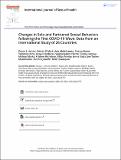| dc.description.abstract | Objective: To determine individual- and country-level factors associated with self-reported changes in solo and partnered sexual behaviors in an international sample of adults during COVID-19. Methods: Data were from the International Sexual Health And REproductive Health during COVID-19 study (I-SHARE)—a cross-sectional, multi-country study (N1⁄426 countries) assessing adult (N 1⁄4 19,654) sexual/reproductive health before and during the first wave of COVID-19. We examined self-reported changes (three-point scale: decreased, no change, increased) in solo masturbation, hugging/holding hands/cuddling with a partner, sex with a primary partner, sex with a casual partner, sexting with a partner, viewing sexu- ally explicit media and partnered cybersex. Ordinal regression assessed the impact of indi- vidual (age, gender- and sexual-identity, romantic partnership status, employment and income stability, household change and content, mental well-being, changes in alcohol use, and changes in marijuana use) and country-level (e.g., Oxford Stringency Index, Human Development Index, and the Palma Ratio) factors on behavior change. Results: The most common behavior to increase was hugging, kissing, or cuddling with a partner (21.5%), and the most common behavior to decrease was sex with a main partner (36.7%). Household factors like job/income instability and having children over the age of 12 years were signifi- cantly associated with decreased affectionate and sexual partnered sexual behaviors; more frequent substance use was linked to significantly increased solo, partnered, and virtual sex- ual behaviors. Conclusions: Understanding changes in sexual behaviors—as well as the fac- tors that make changes more or less likely among adults around the world—are important to ensure adequate sexual health support development for future public health emergencies. | en_US |

